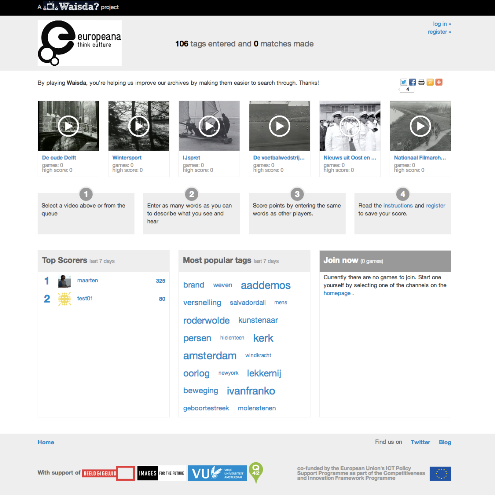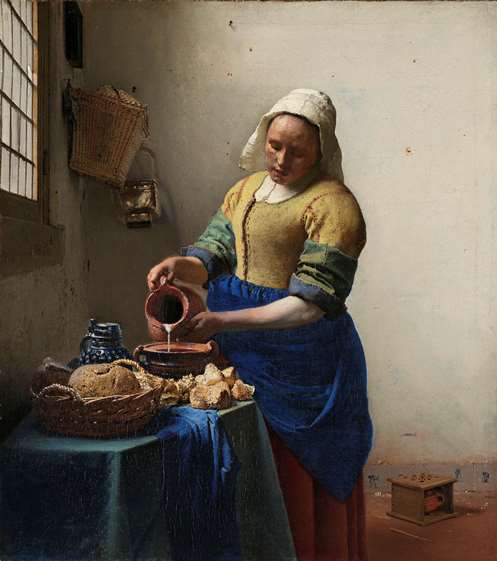Social Semantic Web: Interview with EuropeanaTech
Last week, EuropeanaTech released two major new documents. Today's blog looks at the work and the people behind one of them, interviewing Maarten Brinkerink and Marlies Olensky.
First of all though - a quick look at the two new documents.
The first, titled, 'Core Inventory of FLOSS in the Cultural Heritage Domain, second iteration' analyses the Free/Libre and Open-Source Software landscape and provides a baseline for the development of innovative applications in the Europeana Network.
The second, called 'Functional specifications for social semantic functions' is the first step in a process of building two prototypes that will articulate user-generated metadata with semantic functions in Europeana v2.0's R&D work package. It provides functional specifications and a description of prototypes. To find out what that's all about, we've spoken to two of the minds behind it.
What is your day-to-day role/where do you work?
Maarten: I'm a project manager for Research & Development at the Netherlands Institute for Sound and Vision, mainly working on projects that aim to provide meaningful access to digitised audiovisual heritage.
Marlies: I'm a researcher at the Berlin School of Library and Information Science (Humboldt-Universität zu Berlin) where I work on the Europeana v2.0 project. I've previously been involved in another Europeana project: Europeana Connect where I worked on the semantic data layer (2009-2011). I'm also doing my PhD, which is not related to cultural heritage but is about data quality in bibliometric studies.
What is your involvement with Europeana?
Maarten: For the Europeana v2.0 project, Sound and Vision works on several tasks within the 'innovation' work package, including one on the developers' network and FLOSS inventory and one on the development of innovative apps. The aim of the work package is to foster a research and development community around Europeana, to stimulate innovation that benefits the projects, Europeana Network and the broader cultural heritage domain.
Marlies: Like Sound and Vision, Humboldt University is a partner in the innovation work package, responsible for the Semantic Web & Linked Data and multilinguality tasks. The aim of the Semantic Web & Linked Data task is to make Europeana more 'semantics aware' and to integrate it into the emerging paradigm of Linked (Open) Data.
Tell us about the 'Functional specifications for social semantic functions' work. What problem are you trying to solve?
Marlies: The aim of the task was to demonstrate and try out some options for social semantic web functions that could be useful for Europeana. The semantic web is basically the idea of turning the web into a web of data that can be processed by machines, so it adds machine-readable metadata to human-readable web documents. The social part here means that we would like to employ the users to make this vision happen. In other words, we looked for ideas for what or how the user can contribute to existing content by tagging, correcting, or organising objects or their metadata. So, we tried to come up with innovative functionality that can be tested out using the prototype tools we developed.
Maarten: The functional specifications for social semantic functions and prototype code builds on earlier research done within the work packages on identifying open source tools for the cultural heritage domain (led by Sound and Vision) and the social semantic web (lead by Humboldt). It describes how two selected open source tools (the Waisda? Video Labelling Game and Crowdcrafting) can be further developed to support metadata enrichment via crowdsourcing. Waisda? is a crowdsourcing video annotation platform that has been released as an open source framework by Sound and Vision. Crowdcrafting/PyBossa is a platform for creating and running crowdsourcing applications that utilise online assistance in performing tasks that require human cognition, knowledge or intelligence such as image classification, transcription, geocoding and more.

Screenshot from Crowdcrafting/PyBossa
What was your involvement in this work?
Marlies: In the beginning, I researched what social semantic web solutions are already out there. Then we had several brainstorming sessions to discuss possible functionalities for the two selected tools. We had a very good and close cooperation between Maarten and his colleagues at Sound & Vision and myself which in the end led to a very satisfying document on functional specifications. Sound & Vision was then responsible for developing the prototypes.
Maarten: Sound and Vision supported Humboldt University in writing the functional specification and further developed the tools in the form of prototypes that showcase the functionality that is described in the deliverable.
What challenges did you encounter?
Maarten: When setting up these open source tools for datasets on Europeana, we noticed that only a few data providers are linking out to their digital objects in their metadata. We set out to make tools that could actually present rich content - instead of only metadata - to the users during the crowdsourcing tasks. Another challenge was to find suitable controlled vocabularies to support users in describing the material. Ideally, these vocabularies should fit with the content, be available in SKOS, be licensed for free re-use and be multilingual.
Marlies: For me, the main challenge was the one Maarten already mentioned: As we (along with data providers) employ controlled vocabularies to describe the information objects in a standardised way so as to make them retrievable. It was important to find suitable ones that match the terms that users would want to use to describe objects. Another challenge was narrowing down the functionality options we wanted to try out first and identifying those that seemed most feasible.
What have you achieved?
Marlies: Well, I think we've created an important showcase by demonstrating what kind of social semantic web functions could be leveraged to improve or augment Europeana content.
Maarten: By creating prototypes based on the functional specifications written by Humboldt, Sound and Vision was able to further develop two crowdsourcing tools, enhancing the opportunities to re-use them in the Europeana context. As a result of this work, it is now relatively easy for Europeana data providers and/or projects to set up their own instance of either or both tools. A European data importer was built for both tools, using the Europeana API, so others will be able to set up their own crowdsourcing tasks.
What are the next steps?
Maarten: Next we will further develop the prototypes to encompass all functionality that is described in the report and make the code available to the Europeana Tech community, allowing for Europeana projects and data providers to set up their own instances of the tools to enrich their metadata via crowdsourcing. The European Film Gateway has already shown interest in re-using the Waisda? Video Labelling Game technology.
Marlies: Indeed, and Humboldt will support Sound & Vision in this second development phase where needed.

Screenshot from Waisda?
What response are you looking for from readers?
Maarten: We look forward to feedback on the specifications, suggestions on further developing the prototypes and pointers to controlled vocabularies that could be used for a next iteration.
How can people contact you with their feedback?
Maarten: They can send me a message through Twitter: @mbrinkerink or drop me a line at mbrinkerink [at] beeldengeluid [dot] nl.
Marlies: You can get in touch with me at marlies [dot] olensky [at] ibi [dot] hu-berlin [dot] de.
Finally, a little something beyond Europeana. What do you do when you're not working?
Maarten: When I'm not working I write and record music. I used to perform quite a bit as well, but I'm currently in between bands. I'm also a volunteer for Wikimedia Netherlands, helping them to join forces with cultural organisations.
Marlies: At the moment, I don't have much free time, as most of my time is dedicated to my PhD research. But I do need some balance which I find in travelling, practising yoga and spending time with my family and friends.
What is your favourite item from Europeana?
Maarten: 'Het melkmeisje' by Vermeer. I chose this item not only because is it is a visually compelling and quite iconic piece of art. But for me it is also a best-practice example of how cultural heritage is accessible through Europeana. The Rijksmuseum has really raised the bar for providing open access to art collections on an international level. Their metadata is available through an open API under a CC0 licence, allowing for aggregation by, among others, Europeana. They explicitly mark the works in their collection that are in the public domain as such, using the Public Domain Mark and, last but not least, they provide links to beautiful high resolution digital representations of the artworks.

The Milkmaid, Vermeer. Rijksmuseum, public domain
Marlies: My favourite item in Europeana is a radio recording that is a curiosity about my home country, Austria and my current country of residence, Germany. It's a recording from 1978 when Austria beat Germany at the soccer world cup in Cordoba, Argentina, (for the first and only time in a world cup). And believe me, everyone in Austria is still proud of that victory and nobody in Germany even remembers that match any more! Listen to the recording.
